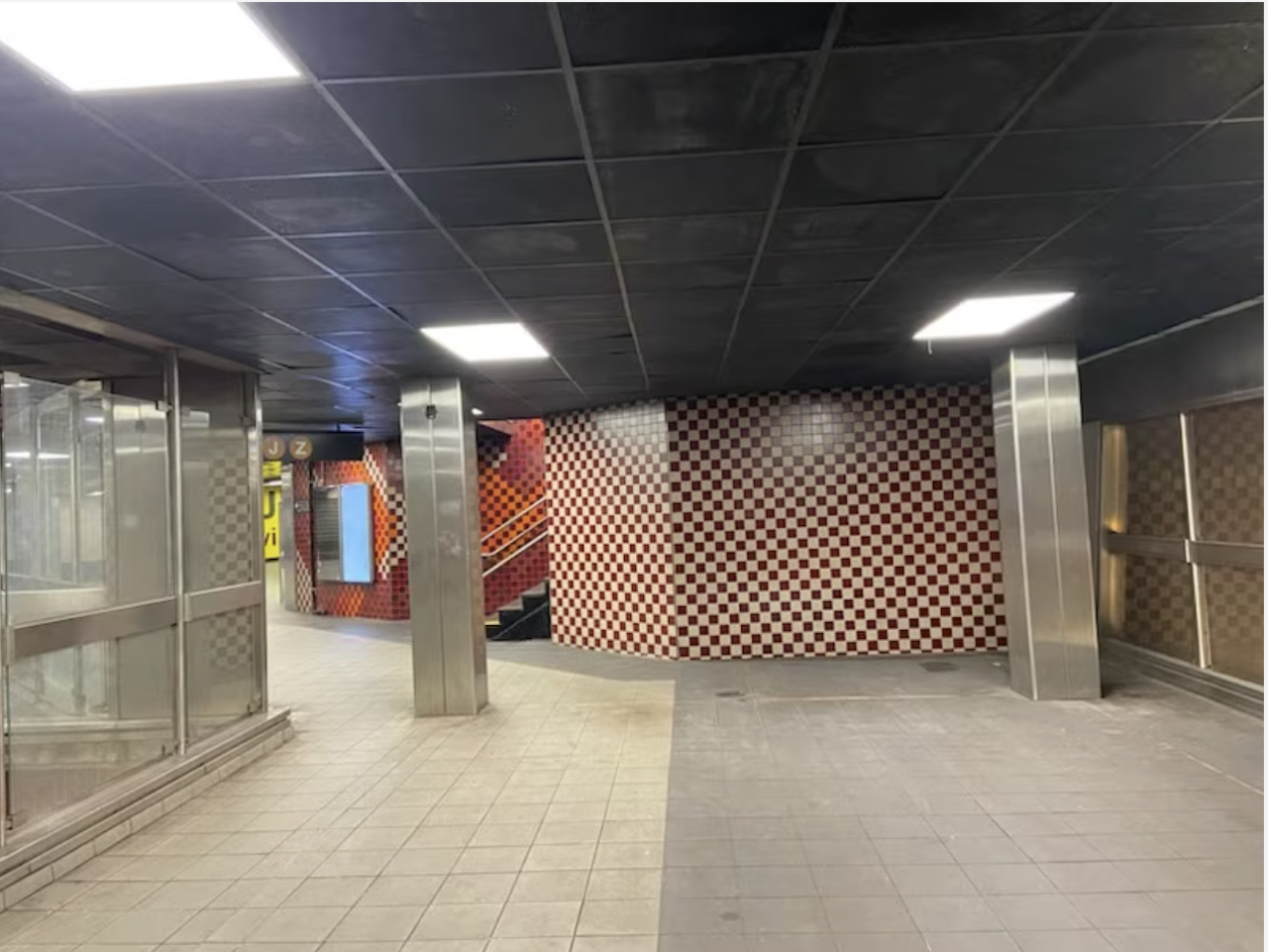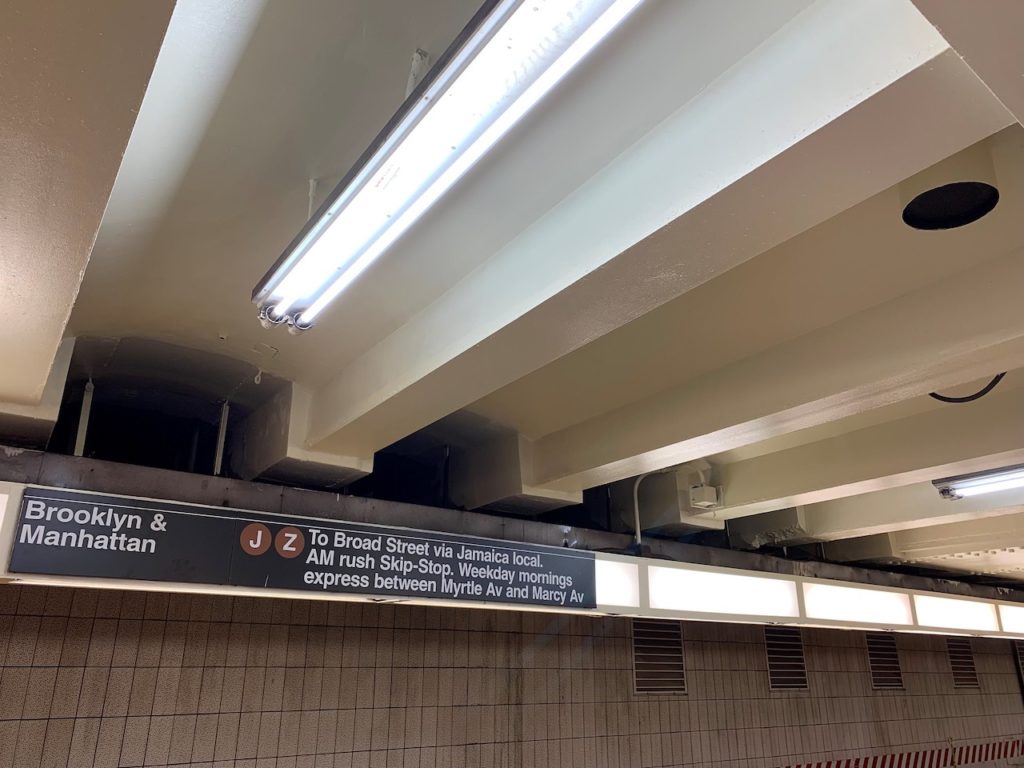
Transit Briefs: NYMTA, LA Metro, Amtrak/CSX/VRE
Written by Carolina Worrell, Senior Editor
MTA photo
The New York Metropolitan Transportation Authority (MTA) completes renovation of the J/Z line section of the Sutphin Avenue JFK Airport subway station, as part of New York City Transit’s (NYCT) Re-NEW-vation campaign. Also, LA Metro launches Equity Information Hub; and the State of Virginia partners with Amtrak, CSX and Virginia Railway Express (VRE) on the Long Bridge project.
NYMTA
The New York MTA on May 8 announced that crews have completed renovation of the J/Z line section of the Sutphin Blvd-Archer Av JFK Airport subway station in Jamaica, Queens, as part of NYCT’s Re-NEW-vation campaign to bring targeted resources to rebuild components of the station within a 55-hour window.
According to MTA, while a track outage was in effect to accommodate escalator replacement work, NYCT crews brought several enhancements to the station to reveal a brighter, fresher station. Crews scraped, primed and painted the entire station, installed new LED fixtures in poorly lit areas, replaced wall, ceiling and floor tiles where needed, and replaced the iconic stairway square green lights. Rehabilitation work was also done at critical back-of-house facilities utilized by NYCT employees.

In March, MTA announced its next round of stations to undergo re-NEW-vation efforts, placing them on track to meet the goal of completing 50 stations by the end of 2023. To date, NYCT has completed 27 re-NEW-vations, and up next is the Zerega Av station.
“The Sutphin Blvd-Archer Av subway station is one of the busiest stations in Queens with its direct connection to the JFK Airport and Long Island Rail Road, so we’re thrilled that we were able to revamp a part of this multi-platform station,” said NYCT President Richard Davey. “Customer feedback has been overwhelmingly positive from past re-NEW-vation efforts, and we look forward to continuing our progress to deliver noticeable station upgrades and improve the customer experience.”
LA Metro
The Los Angeles County Metropolitan Transportation Authority (Metro) on May 8 announced that it has launched an Equity Information Hub under its Metro Equity Platform (download below) to “enable community members access to its equity-focused initiatives, and resources encouraging active inclusion in the agency’s planning process.” Metro’s Community-Based Organization (CBO) Partnering Strategy is another important tool under the agency’s Equity Platform.
Designed to encourage engagement through publicly accessible content, the Equity Information Hub, Metro says, is a website that “provides data and resources necessary to identify and reduce racial, socioeconomic and gender barriers and ensure all Angelenos have equitable access to agency services and programs.” It provides links to many of Metro’s equity tools, engagement resources, case studies and industry best practices in a centralized virtual location. Language translation capabilities are also available.
“Through its Equity Platform, Metro is dedicated to finding ways to increase access to Metro’s projects, programs and initiatives for all our customers,” said Glendale City Council Member and Metro Board Chair Ara J. Najarian. “It is through these efforts that Metro can become the transportation of choice as well as an economic catalyst for our county.”
According to Metro, the Equity Information Hub highlights the Equity Planning and Evaluation Tool pilots, including one that is being implemented for the Long Beach-East L.A. Corridor Mobility Investment Plan (formerly I-710 Task Force), which reflects a community-focused approach for improving communities along the Long Beach Freeway (I-710) corridor. Metro seeks to offer multi-modal options to help improve air quality and mobility for people and goods, support and enhance public health, quality of life and make all travel modes safer. The plan includes engaging residents in the cities of Bell, Bell Gardens, Vernon, Los Angeles, Maywood, Huntington Park, South Gate, Cudahy, Downey, Lynwood, Compton, Paramount, Signal Hill and Long Beach. Unincorporated communities of East L.A. and Walnut Park are also part of the corridor.
“Equity is a fundamental part of every aspect of Metro’s work, whether it’s building affordable housing near transit stations, offering reduced fares to families, children, students, and seniors, or collaborating with community-based organizations to reach marginalized communities,” stated Metro Board First Vice Chair Jacquelyn Dupont-Walker. “We must use the equity information hub and other advanced tools to help in our efforts to enhance the quality of life for all residents of Los Angeles.”
The Long Beach to East L.A. Corridor Mobility Investment Plan will eventually implement projects recommended by local community members. Projects could include new bike lanes, more ADA-compliant pedestrian bridges and sidewalks, incentivizing telecommuting programs, micro-distribution hubs and synchronized street signals between cities.
As part of its equity toolbox, Metro says it has developed specific programs to address inequities that transit customers regularly face within marginalized communities, such as South Los Angeles and portions of the San Fernando Valley. This includes Metro’s CBO Partnering Strategy, a guiding document that allows Metro to standardize its approach to building community relationships and working with grassroots community organizations.
“Angelenos depend on Metro as their primary mode of transportation, which is why we must ensure that our planning, engagement, and decisions are equitable for all of our customers as we expand our transit system,” said L.A. County Supervisor and Metro Board Member Hilda Solis. “To that end, we must be attentive to the concerns of our customers—regardless of where they live, work, or recreate.”
According to Metro, the agency’s CBO strategy has been used successfully on the Vermont Transit Corridor Project, which is now studying the possible implementation of a rail line along Vermont Boulevard from Hollywood to South Los Angeles that would connect four active Metro Rail lines.
The Vermont Transit Corridor Project held focus groups, engaged riders at bus stops, hosted and participated in community and school events, provided briefings, organized community listening sessions and partnered with 20 CBO partners during 32 community conversation events. The CBOs that partnered with Metro provide services to stakeholders who traditionally do not engage with the agency’s transportation planning projects. Through this multifaced approach, Metro says more than 6,000 stakeholders shared their thoughts on the future of transit along Vermont Boulevard and Metro established deeper lines of communication with the community.
A similar approach is being used for the Long Beach-East L.A. Corridor Investment Plan (formerly known as the I-710 South Corridor Investment Plan). Early on, Metro worked with 15 CBO partners, including the Long Beach Negro Council of Women, Families in Good Health, Teamsters Local 848, Avance Latino and Salvation Army along with other organizations in the corridor. A CBO administrator will be selected to support the partnerships between the communities and Metro due to the number of stakeholders and cities within the corridor. The investment plan seeks to provide safe, multimodal options to move people and goods while creating healthy, zero-emission, sustainable and equitable solutions for residents in the cities along the corridor.
“This platform will help Metro address the inequities of the past that continue to have an impact today and guarantee transportation investments are prioritized by communities with the highest need,” said L.A. County Supervisor and Metro Board Member Holly J. Mitchell. “Our goal through this work is to ensure that the voices of our customers are heard, no matter their socioeconomic status, ethnic background, or where they reside in the county.”
Other Metro equity-related programs include the GoPass pilot program, Low-Income Fare is Easy (LIFE) and the How Women Travel Report.
“It’s imperative that Metro continue to lead with equity in its projects, programs and service delivery,” said Metro CEO Stephanie Wiggins. “Our Equity Platform contains important tools, like our CBO Partnering Strategy, that we use to identify and remove barriers faced by our customers no matter where they live in Los Angeles County.”
More information about Metro’s equity platform is available here.
Amtrak/CSX/VRE
The State of Virginia is partnering with Amtrak, CSX and VRE on the Long Bridge project, which includes construction of a new, two-track railroad bridge over the Potomac River, to “reduce frequent bottlenecks of passenger and freight trains traveling between Virginia, D.C. and up and down the East Coast,” according to a WTOP News report.
According to the report, the addition of the new bridge, which will be constructed next to the existing two-track, 117-year-old CSX-owned Long Bridge, will double the capacity of trains that cross the river—two tracks will be dedicated to passenger rail and two will be for freight rail use.
While the Long Bridge project is one of the Phase 2 aspects of the $3.7 billion Transforming Rail in Virginia program, one local project is expected to begin construction by spring 2024, according to the WTOP News report.
Currently, the Alexandria VRE and Amtrak station on King Street has a total of three tracks, which serve both passenger and freight traffic.
Final design is under way to construct six miles of a fourth railroad track between Alexandria and Arlington. Eventually, WTOP News reports, the four tracks will be integrated with the Long Branch construction, to create an opportunity to separate freight and passenger rail service.
The design should be complete by the end of the year and the Virginia Passenger Rail Authority (VPRA) will begin community outreach in the next several months, stated VPRA Communications Manager Karina Romero, according to the report.



